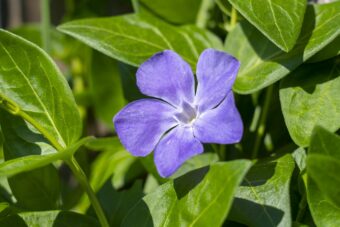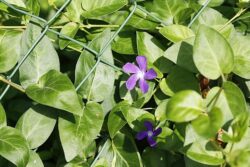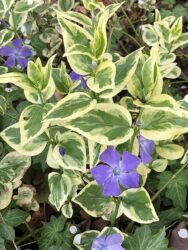In this article, we will discuss how to grow Vincas in containers. Vinca is a trailing plant and looks its best when it is grown from a hanging basket, as an alternative to English ivy. There are two types of Vincas- Vinca minor and Vince major. You can say its Latin name is a big clue, as minor tends to be shorter and has smaller leaves, whilst major is longer and the leaves are larger.

The leaves tend to be glossy, pointed oval in shape and occur in pairs opposite each other. The leaves can be plain green, variegated white or golden yellow, completing an attractive look. The leaves are not the main selling point but the flowers are. It produces bell-shaped, blue, white or mauve flowers. The main reason the plant is grown is that it is easy to look after and it can be difficult to kill. Difficult but not impossible.
They are not fussy plants, as they only require that the compost is moist at all times. It will not be happy if the compost is too dry but at the same time, the compost must never be soggy, as this can lead to root rot.
PLANTING VINCAS IN CONTAINERS
As Vincas naturally grow near riverbanks then you will need to replicate these growing conditions to keep the plant happy. When you buy Vinca plants from shops and garden centres, they will be in flower so you can choose what coloured flowers and leaves you want to purchase.
Fill a container or hanging basket with multipurpose compost, ensuring that it has drainage holes to allow excess water to flow away.

Dig a hole that is slightly larger than the root ball it came in the original container. Add a handful of slow-release fertilizer so to give the plant an initial boast to get it through the growing season.
Place the plant in at the same level it came in the original container-no shallower or deeper. Make sure the crown is never covered as the plant hates it. Backfill it with the multipurpose compost ensuring that any gaps that remain are filled with more compost. Firm the plant in and water well.
For the first few weeks, you will need to water regularly, otherwise, you will kill the plant. Throughout the growing season, you will need to water regularly, especially when the surface of the compost feels dry to the touch.
Spring and summer are the most critical stage when the plant needs moisture the most. In winter, you can let the plant be since normal rainwater will cover the plant needs. Water when 2.5cm below the top of the surface of the compost feels dry to the touch.
Try to water at ground level, so that soil and leaf fungal diseases are avoided.
THEY DO NOT NEED PRUNING
Vincas do not need pruning but if you want a well-behaved plant, growing where you want it to grow then you will need to train it up a trellis or snip misbehaving stems off.

If you want a free-flowering bushy Vinca in a container, you will need to snip stems after every 3 pairs of leaves as it grows. Do this every 4 weeks in early spring and your reward will be plenty of flowers. In containers, it should not produce new plants as long as the stems do not touch the bare soils below.
Every early spring an application of slow-release fertilizer will be enough to feed the plant for the whole growing season. They are not heavy feeders and one application should be enough.
You will need to prune out any dieback that occurs immediately before it spreads.
PESTS AND DISEASES
They tend to be relatively pest and diseases free, but they do suffer from powdery mildew and some insect problems.
If a white dusting occurs on the leaves, then this is powdery mildew. To help treat this, you will need to provide good air circulation around the plant. You will also need to spray an affected plant with a suitable systemic fungicide.
Aphids and spider mites can be problematic which is best dealt with by using a suitable systemic insecticide.
VARIETIES TO GROW
Vinca major tends to grow up to 0.6m long and has many vines, but it is not as rampant as other climbers like Clematis or Jasmine. The flowers are often blue or blue-mauve, but white and red varieties exist. Varieties include ‘Wojo’s Gem’, ‘Maculata‘ and ‘Variegata’.

Vinca minor is shorter, only growing up to 30cm in length. This makes it an ideal plant to use for containers especially hanging baskets. It has flowers in similar colours to V. major. Varieties include ‘Bowles’s Variety’, ‘Gertrude Jekyll’, ‘Illumination’, ‘Atropurpurea’, ‘Azure Flore Pieno’ and ‘Ralph Shugert’. There is a variety called V. minor f. alba.
The easiest way to tell the two species apart is that the leave edges are different. Vinca major has very fine hairs along the edge, whilst Vinca minor does not.
CONCLUSIONS
In this article, we have discussed how to grow both Vinca major and Vinca minor in containers. They tend to be easy plants to look after, only regular watering to keep the plants’ roots happy and only an annual feed in spring. You can stop it from becoming invasive by preventing the stem from hitting the ground by cutting them back regularly,
They are easy to grow in hanging baskets where the colourful leaves and flowers can be appreciated at eye level.
If you have any questions or comments that you wish to make in growing Vincas in containers, please do so in the comment box below.
Happy Vincas growing.
